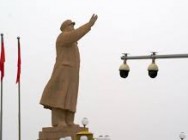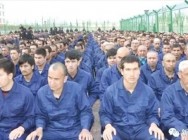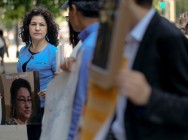Last Minute

- Conflict and Alliance: The US and China: A Centennial Dance: A Century of Relationship from 1900 to 2024
- CHINA RELATIONSEAST TURKESTAN PROBLEM AND TURKEY
- FRONTLINE China Undercover
- Elimination of “Uyghur Counter-Revolutionary Officials” in Academic Fields—Exact Quotes Translated from a Mandarin Audio File
- In Push for Trade Deal, Trump Administration Shelves Sanctions Over China’s Crackdown on Uighurs
- Dalai Lama’s 60th Anniversary Symposium: İlshat Hassan speech in English and Chinese
- Uyghur Detainees from Xinjiang ‘Placed in Nearly Every Prison’ in Shandong Province
- Shahrezad Ghayrat, Unrepresented Women
- Uighur Americans Speak Against China’s Internment Camps. Their Relatives Disappear.
- Rozinisa: The true story of the Uyghur girls in the prison

-

Conflict and Alliance: The US and China: A Centennial Dance: A Century of Relationship from 1900 to 2024
-

CHINA RELATIONSEAST TURKESTAN PROBLEM AND TURKEY
-

FRONTLINE China Undercover
-

Elimination of “Uyghur Counter-Revolutionary Officials” in Academic Fields—Exact Quotes Translated from a Mandarin Audio File
-

In Push for Trade Deal, Trump Administration Shelves Sanctions Over China’s Crackdown on Uighurs
-

Dalai Lama’s 60th Anniversary Symposium: İlshat Hassan speech in English and Chinese
Present-Day Ethnic Problems in Xinjiang Uighur Autonomous Region: Overview and Recommendations (2) – Bilingual Education
By Ilham Tohti, translated by Cindy Carter, published: April 23, 2015
II. Bilingual Education
Overview
Besides unemployment, the issue that provokes the most intense reaction within Xinjiang’s Uighur community is the issue of bilingual education. In practice, “bilingual education” in Xinjiang has essentially become “monolingual education” (i.e. Mandarin-only education.) Within the Uighur community, there is a widespread belief that the government intends to establish an educational system based on written Chinese and rooted in the idea of “one language, one origin.” Suspicions abound that the government is using administrative means to exterminate Uighur culture and accelerate ethnic and cultural assimilation. With the mandatory implementation of so-called “bilingual education,” the Uighur language has become steadily marginalized, not only in the field of education but also in government administration, the judiciary, and other areas. Despite being one of the official languages of the Xinjiang Uighur Autonomous Region, the Uighur language has long been deprived of the respect, attention, status and legal safeguards it deserves.
In practice, the greatest problem with bilingual education in Xinjiang is that it produces a large number of students who are proficient in neither their mother tongues nor in Mandarin. This has led to declining educational standards and difficulties for ethnical students, who dread attending school, to master subjects. The bilingual education system in Xinjiang mandates that physics, chemistry, biology, mathematics and other subjects be taught in Mandarin Chinese, which means that Uighur and other ethnic minority students are often unable to understand what they are being taught. This policy is responsible, to a large extent, for the steady increase in dropout rates for Uighur and other ethnic minority students. Another consequence is that many experienced Uighur primary school teachers have been forced into early retirement or made to leave their faculty positions for jobs unrelated to teaching. Thus, a large number of Uighur schoolteachers have become direct casualties of government policy on bilingual education.
“Bilingual education” in Xinjiang has increasingly given way to “monolingual education,” raising grave concerns and causing serious repercussions. This has the potential to spark a larger-scale Uighur rights movement aimed at defending Uighur language education and preventing the extermination of local language and culture. In recent years, Uighur fears of cultural and linguistic annihilation have been greatly exacerbated by a sharp contraction in Xinjiang’s local-language publishing and cultural industries.
This sudden dwindling of Xinjiang’s Uighur-language publishing and cultural industries has profound and far-reaching consequences. Not only does it threaten the demise of Uighur culture and the suppression of Uighur intellectuals, it has also caused vast swaths of the Uighur community, most of whom live in isolated rural areas, to become completely cut off from contemporary civilization. Southern Xinjiang, taken as a whole, is extremely backward: it is a geographical backwater of scattered, insular oases, and the vast majority of its Uighur inhabitants do not understand Chinese. For these reasons, the majority of households in southern Xinjiang are cut off from books, newspapers, radio broadcasts and television programs offering up-to-date information or news about the outside world.
This severing of communication channels means that, notwithstanding a small number of Uighur elites fluent in Chinese, most traditional Uighur communities are utterly deprived of access to contemporary news and information. In an increasingly competitive and open social environment, this makes Xinjiang’s traditional Uighur communities inherently less adaptable to external stimuli than traditional Han Chinese communities in other areas of China. When people are unable to attain the knowledge essential to a modern society, unable to cultivate strength of character for modern life, or to acquire healthy modern societal values such as rationality, tolerance and open-mindedness, they may find themselves in crisis, consumed by fear that they are being increasingly abandoned by modern society. The rapid disintegration of traditional society and the challenges of adapting to a new environment can leave people mired in ignorance, parochialism, savagery and despair.
Over the past ten years or so, traditional Uighur society has experienced an unprecedented surge in crime rates, the rapid disintegration of morals, and the spread of religious extremism and cultural conservatism. Add relative impoverishment and an increasing hatred of Han Chinese, and you have a vicious circle that intensifies day by day. It is this, combined with misguided government ethnic policies, that has allowed backward, ignorant, parochial, extremist, isolationist and fanatical ideologies to proliferate, creating a breeding ground for “the three forces” [of separatism, religious extremism and terrorism.]
Measures such as preaching national unity, making minorities reliant on government handouts, and accelerating the Sinification of China’s Uighur communities are not a sufficient bulwark against separatism, religious extremism and terrorism. Contrary to the common perception of Uighur cultural, educational and publishing industries as being too prone to strengthen Uighur ethnic and cultural awareness, it is only by allowing these industries to develop and thrive, to keep pace with the times and with history, that we can weaken “the three forces” [of terrorism, religious extremism and separatism] by denying them ground in which to take root. This is the only feasible long-term method by which to defeat them.
Therefore, we may say that the backwardness of Uighur cultural, educational and publishing industries is not only the enemy of Uighur society, but also the enemy of Han Chinese society.
In fact, nearly all Uighur families want their children to receive a better-quality education in Mandarin Chinese, and they feel that genuine “bilingual education” has come too late. Yet at the same time, the prevailing view and mainstream opinion in Uighur communities is that “Bilingual education should not come at the expense of one’s mother tongue.” Mandarin’s special status as China’s lingua franca should not make it an excuse for linguistic discrimination or forced linguistic assimilation. In a nation of diverse ethnicities, shared cultural values should be expressed in diverse ways, not subject to standardization or unification. Education should not be made the “executioner” of native languages and scripts.
As for why “bilingual education” in Xinjiang has devolved into “monolingual education,” the answer lies in the slapdash way in which bilingual education policy has been implemented:
1. Deficiencies in technical and basic preparations (i.e. finding qualified faculty, investing in school and facilities construction); inadequate consideration of regional differences and local needs; implementing educational policy in a “one size fits all” fashion.
2. Academic content and curricula that do not take into account either the specific academic needs of ethnic Uighur students, or the successful experiences of schools in China’s other ethnic regions.
3. Xinjiang’s limited allotment of teaching staff, poor infrastructure and low student academic abilities were scarcely sufficient for a monolingual education program, much less a full-scale bilingual education program.
4. Implementing “bilingual education” has actually exacerbated the educational funding gap between Han Chinese and Uygur students. For example, in the city of Atushi [also spelled Atush or Artux], the Han Chinese population numbers 22,725, the Uighur population 198,217, and the Kyrgyz population 29,186. If we do not count the Municipal No. 2 School, located forty kilometers outside of the city, Atushi has only three high schools: one Chinese-language school (Prefectural No. 2 High School) and two Uighur-language schools (Prefectural No. 1 High School, and Municipal No. 2 High School). Class sizes in the Uighur schools average more than 50 students per classroom, whereas the Chinese school averages only 30 students per class. Differences in teaching quality and levels of educational investment have widened the educational gap between Han Chinese and Uighur students, both in terms of their access to knowledge and their ability to master new subject matter.
Thoughts and Recommendations
1. Xinjiang needs true bilingual education. The [Korean-language] bilingual education program in Yanbian Autonomous Prefecture is a typical success story. Xinjiang can draw from that experience in restructuring its own bilingual educational content and curriculum.
2. In ethnic-minority populated areas, increase investment in the hardware and software required to provide true bilingual education, and redress the grievous imbalance in educational resources allocated to different ethnic groups.
3. Train qualified teachers. Currently, the biggest impediment to bilingual education is a serious shortage of qualified teachers. It will be difficult to alter this situation in the short term, but by focusing on systematic training of existing teachers, we can gradually reduce or dispel the regional disparities among teachers of bilingual education.
4. Exam-based university selection of minority students: although the current system of adding points to the university entrance exam scores of ethnic minority test-takers is in line with the central government policy of favoring minority candidates, in practice, many of the true beneficiaries of this preferential scoring system are academically-accomplished minority students who do not require preferential treatment, or even affluent, well-connected Han Chinese students. It might be possible to replace the “added points” section of the exam with test matter related to Xinjiang’s ethnic and cultural diversity. Not only would this signal to Uighur students that Xinjiang’s multi-ethnic and multi-cultural traditions have not been forgotten by the educational system, it would also deepen everyone’s understanding of Xinjiang’s ethnic and cultural diversity, thus shaping a richer and more inclusive national identity and consciousness.
5. Raise the number and prestige of ethnic minority cultural and publishing endeavors, in order to reverse the rapid decline of minority cultural industries. In terms of fiscal policy, increase government investment and support for ethnic minority cultural, educational and publishing industries, and accelerate Uighur-language participation and access to modern information technology. Both the regional and the central government should advance Uighur rural society by promoting knowledge about modern social life and modern production methods, and making this a key element in long-term planning.
With regard to Uighur folk culture, the government of the Xinjiang Autonomous Region should search for ways to encourage and support grassroots cultural initiatives in this field. The regional government should also begin experimenting with gradual reforms of the ethnic minority cultural and educational publishing industries: for example, introducing market-based mechanisms or objective quality targets, harnessing the initiative and enthusiasm of existing staff, and avoiding the current problem of overstaffing.
6. Increase regional or national government support for specialized research and scholarship on the social transformations affecting Uighur communities. Encourage the participation of mainland Chinese and even overseas scholars and academics, so that China’s rulers may draw on their collective wisdom and counsel to resolve the nation’s ethnic and social dilemmas. In mainland China at the moment, there is an almost complete dearth of worthwhile academic research on this topic. One hopes that if scholars are allowed more academic independence, it will help to fill this void.
7. Establish a plan and systematic targets for training a new breed of top-tier ethnic minority intellectuals, and incorporate them into national planning via funding for specially earmarked projects.
Xinjiang suffers from a dearth of ethnic minority intellectuals, at least those who meet the strict modern criteria for intellectuals. Moribund educational and research institutions and outmoded systems of personnel training and advancement have deprived Xinjiang of a true community of ethnic minority intellectuals. Whether the task is promoting social progress in Xinjiang, improving the lives of ethnic minorities, or advancing national identity and cohesion among minority elites, a highly qualified community of ethnic minority intellectuals is essential to the task. Allowing more ethnic minority intellectuals to enter the mainstream confers honor upon them and their communities, and that honor serves to strengthen their sense of national identity and cohesion.
http://chinachange.org/2015/04/23/present-day-ethnic-problems-in-xinjiang-uighur-autonomous-region-overview-and-recommendations-2/
RELATED NEWS












